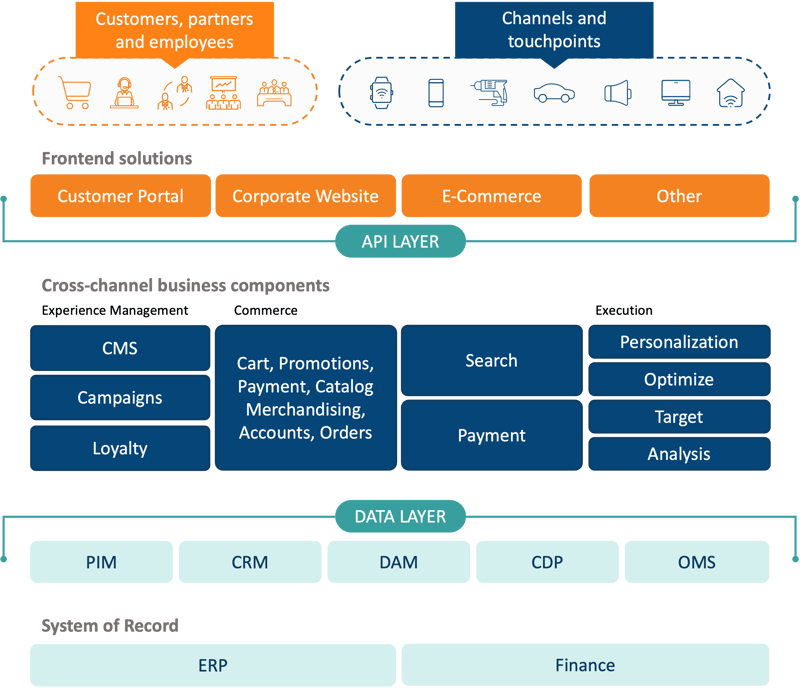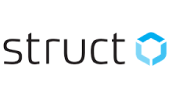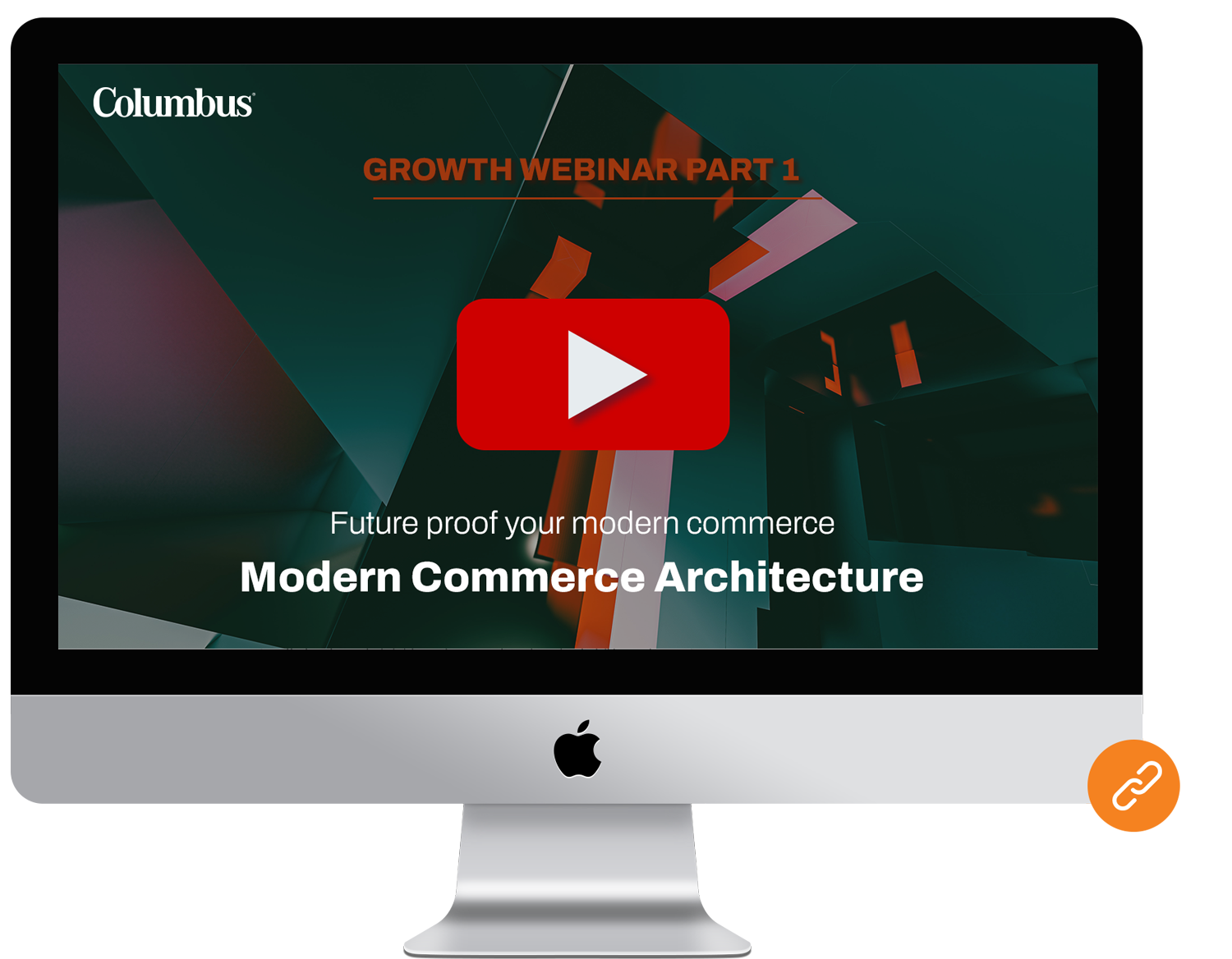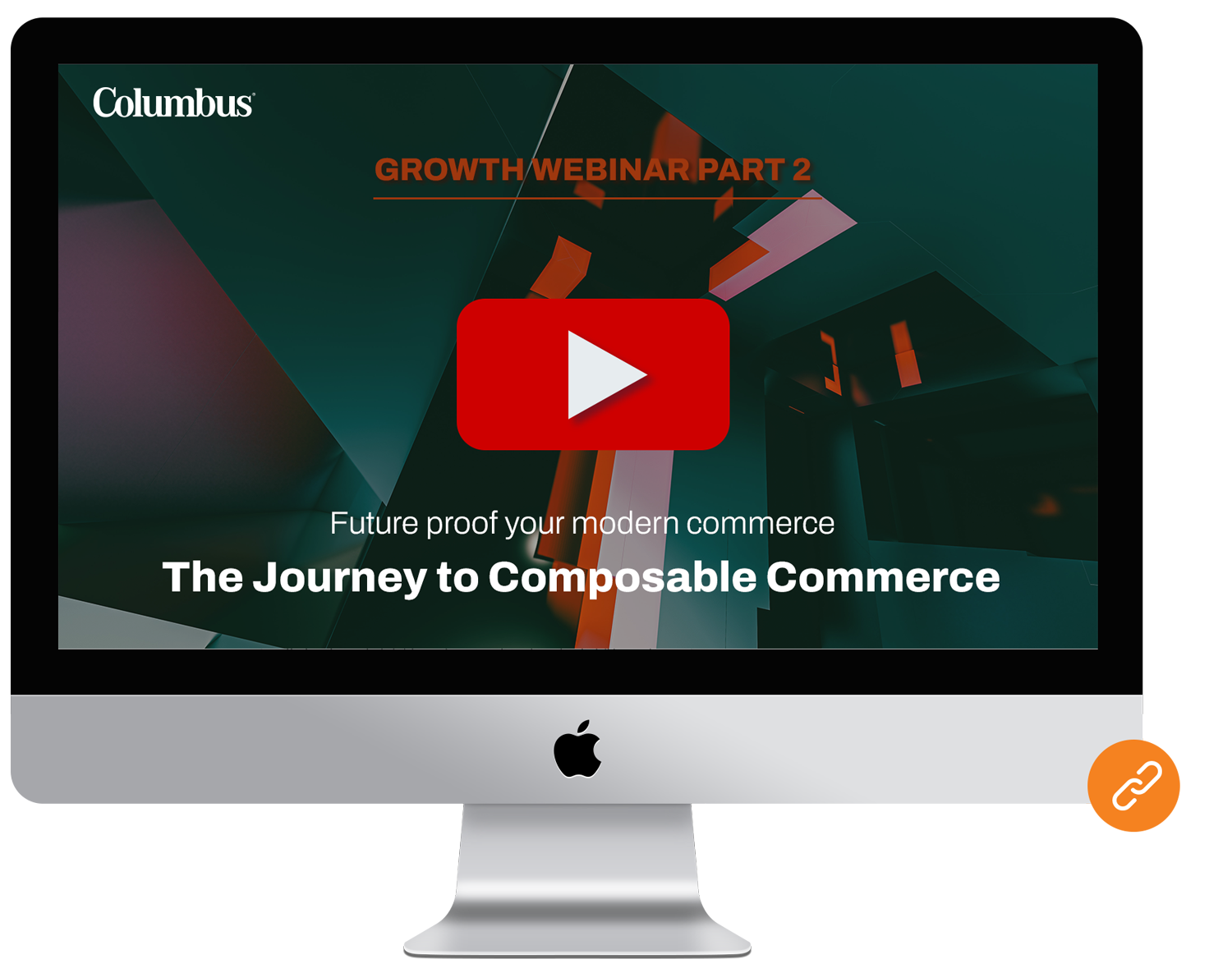Futureproof your Commerce
If you want to sell online to any significant degree today, you must take a careful look at composable commerce, also referred to as modern commerce. This new trend represents a whole new way of building online stores for companies with large transaction volumes and/ or companies who strives for speed and flexibility in change.
Over the past 10-20 years, commerce has gradually moved from the physical to the virtual world. First came online stores, which initially competed with physical stores. Today, all stores offer e-commerce and this is just one of many digital channels for most companies. All purchases and sales are now made on an omnichannel basis – in online stores, apps, social media, digital communication channels and in physical brick-and-mortar stores. Similarly, the store window and customer interactions have also been digitalized and take place in many different virtual channels while traditional channels still remain important.
To succeed, both today and in the years to come, in such a diverse landscape of sales channels, customer interactions and product presentations, which are also constantly changing, you must use the right technology in the right way. You need the agility to be able to react quickly to changes in consumer behavior, launch new products and change the way you do business.
By 2023, organizations that have adopted a composable approach will outpace competition by 80% in the speed of new feature implementation
Source: Gartner
Why modern Commerce is important
The industry has undergone major changes in the last 10-20 years and the technology used has transformed right along with the industry. Until very recently, all online store operations were managed in large, monolithic E-commerce solutions. Everything from catalog management and product information (PIM) to sales and payments were managed in this same system. And this is still the case for many companies.
One disadvantage of the traditional monolithic systems is that it is rare for one vendor to deliver the best solutions for all features. While some of the system’s features are great, you’re also stuck with the features that are weaker. These types of systems can also be time-consuming, expensive and cumbersome to develop and update in line with new and future requirements.
These days, it is increasingly common to use different applications and programs to solve different business needs. This is represented by the term composable commerce, which is equivalent to a modern e-commerce architecture.
So what is this new technology?
Simply put, a modern e-commerce architecture is a fresh approach to the use of technology in industries that involves handpicking the best technology and combining (composing) different applications to create the best possible platform tailored to the individual need.
With composable commerce, we meet business needs by building a solution composing best-of-breed technologies and IT services from different vendors to create a complete digital commerce platform. This opens up vast potential for retail companies to develop a unique solution that stands out from the competition. At the same time, composable commerce future-proofs your business by laying the technological foundation to meet tomorrow's needs.
If your needs change, or a much better business capability comes out on the market, you can simply replace one capability with another instead of having to update the entire solution. More on this below.
MACH is the backbone of a modern architecture
The composable strategy is not only gaining a foothold in the specific industry. According to research firm Gartner, the transition to a composable enterprise strategy for IT and business operations is underway among the leaders in the digital transformation of business models and industries.
However, it's important to be aware that a modern e-commerce architecture requires certain technological and strategic choices. The most important of these are guided by four principles: Microservices-based, API-first, Cloud-based and Headless (MACH). In practice, this means a consolidated IT architecture consisting of the following components based on the MACH principles:
 Microservices-based: Microservices are small independent services that you package to business capabilities to meet specific business needs. Microservices represent a variant of a service-oriented architecture in which each core function, or service, is built and deployed independently of other services in the same application and/or other services. Microservices make it possible to rapidly respond to new business needs and bring new features to market faster. Different microservices communicate and collaborate with each other using APIs.
Microservices-based: Microservices are small independent services that you package to business capabilities to meet specific business needs. Microservices represent a variant of a service-oriented architecture in which each core function, or service, is built and deployed independently of other services in the same application and/or other services. Microservices make it possible to rapidly respond to new business needs and bring new features to market faster. Different microservices communicate and collaborate with each other using APIs.
 API-first: An application programming interface (API) uses standardized methods and protocols to enable applications to exchange information with each other. An API serves as the link that allows different applications and IT services to be integrated and seamlessly interoperate. One of the ways APIs benefit users is by saving them the trouble of having to enter the same data in two different systems. Another is by providing a holistic customer experience. This is possible because data associated with the user is retrieved from multiple systems but presented in the same interface in one place. One of the distinguishing features of cloud services is the use of APIs.
API-first: An application programming interface (API) uses standardized methods and protocols to enable applications to exchange information with each other. An API serves as the link that allows different applications and IT services to be integrated and seamlessly interoperate. One of the ways APIs benefit users is by saving them the trouble of having to enter the same data in two different systems. Another is by providing a holistic customer experience. This is possible because data associated with the user is retrieved from multiple systems but presented in the same interface in one place. One of the distinguishing features of cloud services is the use of APIs.
 Cloud-based: Some of the benefits of true multi-tenant cloud services is that they are easy to scale, users have access wherever they are, and you avoid substantial CapEx in your own IT infrastructure, hardware and software licenses. You also avoid risky and expensive upgrade projects because cloud applications are always updated. Cloud applications are subscription-based, meaning that companies pay only for what they use (OpEx), avoiding upfront CapEx.
Cloud-based: Some of the benefits of true multi-tenant cloud services is that they are easy to scale, users have access wherever they are, and you avoid substantial CapEx in your own IT infrastructure, hardware and software licenses. You also avoid risky and expensive upgrade projects because cloud applications are always updated. Cloud applications are subscription-based, meaning that companies pay only for what they use (OpEx), avoiding upfront CapEx.
 Headless: The term headless means that the digital space in which your customer sees your products or services (the frontend/presentation layer) is separated from the business logic layer (the backend). A headless approach gives you the freedom to design a unique digital user experience for each channel. You also get the flexibility to leverage data from today's ERP systems and other business logic with emerging technologies such as Augmented Reality (AR) and Virtual Reality (VR) and with sensors, cash registers and similar in-store data sources.
Headless: The term headless means that the digital space in which your customer sees your products or services (the frontend/presentation layer) is separated from the business logic layer (the backend). A headless approach gives you the freedom to design a unique digital user experience for each channel. You also get the flexibility to leverage data from today's ERP systems and other business logic with emerging technologies such as Augmented Reality (AR) and Virtual Reality (VR) and with sensors, cash registers and similar in-store data sources.
Guide to a Composable Commerce
What's the latest in e-commerce? In our guide Increase experiences with a composable approach, 4 of our top experts run through the trends for the upcoming year – and what you need to keep in mind to stay ahead of your competitors.
Key takeaways in the guide:
-
Insider tips from experts
-
How to future-proof your e-commerce business
-
The latest digital commerce trends within modern commerce, D2C, composable,
social commerce and more -
An overview of key market and technology trends
Five benefits of Composable Commerce
Composable commerce is the answer if you want to develop a digital platform that empowers compelling shopping and customer experiences. Composable commerce offers five major benefits:
1. Customization: With composable commerce, you can customize the appearance of your online store to your customers and the entire shopping experience independently of a single software vendor’s solution. You have full control and can design customer interactions according to your strategy and branding. The benefits of customization include a stronger brand and increased sales.
2. Experimentation: Composable commerce allows you to experiment with different customer and user experiences (UX) without putting your entire business at risk. For example, you can run A/B tests on a part of your website or attempt sales via Messenger or WhatsApp without affecting your underlying ERP and other systems in the business logic layer. The benefits of this experimentation capability include making it easier to test ideas and to obtain feedback on new business ideas faster. This way, you can build a culture of innovation within your company.
3. Agility: You can quickly change the design and customer experience because the underlying ERP and other systems in the business logic layer are not affected and because multiple teams can work and develop solutions in parallel. The benefits of this agility include making it faster to adapt designs and customer experiences to seasons, sales days and market trends.
4. Scalability: With composable commerce, each module of your retail platform can be independently scaled and customized based on usage and load. For example, a large number of visitors to your online store will not impact purchase functionality. The benefits of this scalability include no disruption to buying and selling from traffic peaks, which leads to increased sales and a better customer experience.
5. Touchpoint flexibility: With composable commerce, you can easily add new touchpoints and sales channels wherever your customers are. These may include touch screens or smart mirrors in your physical stores. Or you could have one-click purchases in showrooms with home delivery. You can also increase customer engagement with smart loyalty programs or apps. The benefits of this flexibility to easily add new touchpoints include a better customer experience, extended customer relationships and the capability to leverage new sales channels and trends.
Skyrocketed Composable Commerce with N3XT®
We urge you to unleash your full commerce potential with our Columbus N3XT® accelerator.
Launch your organization into the composable commerce arena with best-of-breed systems, pre-built modular architecture, and pre-selected leading partners Commercetools, Klevu, Vue Storefront and Contentful.
How to succeed with a modern ecommerce architecture
To successfully implement a composable architecture, the technologies and solutions that comprise your retail platform must interoperate seamlessly and smoothly. To make that happen, you need a skilled and experienced technology partner who can advise on technologies and business strategies while also implementing the modules needed and getting each system to work together.
A typical composable commerce technology stack includes services that cover all the features normally included in a traditional monolitic platform.

Future-proof your modern commerce
Increasing competition and rising customer expectations mean companies need to be fast and flexible. Organizations that rely on E-commerce as a core part of their existing and future business model need to adapt to keep a competitive edge – as such, many are transitioning to a modern commerce platform for
digital business.
Watch the Webinar series
In this 2-part webinar series, we delve into what you should focus on the journey to implementing a modern commerce architecture for your business. Like why and how you adapt to meet your customer's future expectations and how to use it to be relevant, agile, and ready for the future.
Related blogposts
What can we do to make e-commerce more environmentally sustainable?
Learn More
We collaborate with the market's strongest vendors

















